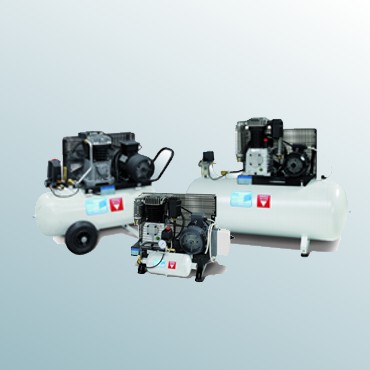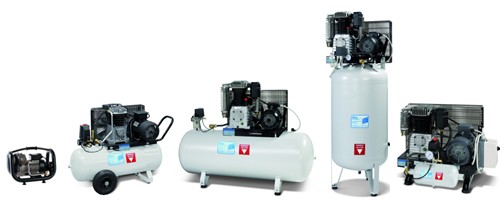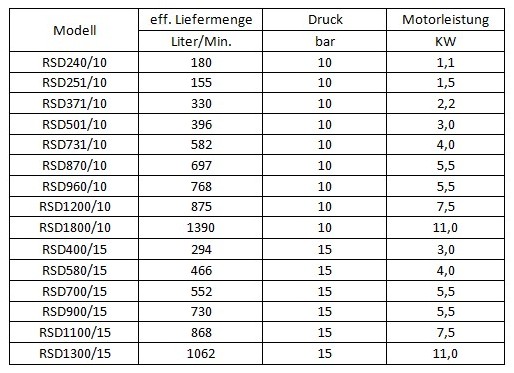Portfolio

Piston compressors Series RSD
The piston compressors were specially developed for craftsmen and workshops. Particular emphasis was placed on good cooling with optimum heat dissipation, which is crucial for a long service life. The compressor units operate at reduced speed. This makes them low-vibration and have a lower noise level. Furthermore, the reduced speed contributes to maintaining operational reliability even under higher loads. Special foundations are not required.
The compressors are available in different versions:
- portable with 5 liter tubular frame pressure tank
- drivable with 50 or 90 litre pressure vessel
- 270 or 500 litres Pressure vessel horizontal or vertical
- as add-on unit
- partially available with acoustic enclosure


Features of our handicraft and workshop series Ricocomp
- belt drive
- star triangle switch from 5.5 kW rated motor power
- Pressure reducing valve up to 2.2 kW / Filter pressure reducing valve from 3.0 kW
- Pressure switch, pressure gauge, safety valve, ball valve
- Motor power from 1.5 to 7.5 kW
- max. operating overpressure 10 and 15 bar
- Volume flow rate 160 to 875 l/min
The Ricocomp Series
Ricocomp compressors have been specially developed for craftsmen, workshops and businesses. Particular emphasis has been placed on good cooling with optimum heat dissipation, which is essential for long compressor life.
The Ricocomp compressor units operate at reduced speed. This makes them low-vibration
and have a lower noise level. Furthermore, the reduced speed contributes to maintaining operational reliability even under higher loads. Special foundations are not required. All Ricocomp systems are delivered to the customer only after an extensive test procedure, thus guaranteeing maximum operational safety and reliability.
Piston compressors for workshop applications
Most people probably think of a piston compressor when they think of a compressor. Perhaps you already know the two basic principles of air compression. One of these principles is displacement compression. There are a variety of compressor types that are classified as positive displacement compressors. The oil-lubricated or oil-free piston compressor is one of them.
What are piston compressors?
The piston compressor is the oldest and most frequently used industrial compressor. It is available as a single-acting or double-acting version, as well as an oil-lubricated or oil-free version, with different numbers of cylinders in different configurations. With the exception of very small compressors with vertical cylinders, the V configuration is the most common variant for small compressors. For double-acting, large compressors, the L configuration with a vertical low-pressure cylinder and a horizontal high-pressure cylinder offers enormous advantages and is the most common design.
Oil-lubricated compressors usually work with splash lubrication or pressure lubrication. Most compressors have self-acting valves. A self-acting valve opens and closes due to pressure differences between the two sides of the valve disc.
The piston compressor compresses the air/gas by means of a piston which compresses it in a sealed housing and then releases it in a specific direction for specific purposes. Control is provided by one or more crank drives if the system is a multi-piston compression system. The work of the pistons is cyclic. The volume flows of a reciprocating compressor are rather low, but they generate high pressures.
What are oil-free piston compressors?
Oil-free piston compressors have piston rings made of PTFE or carbon, and alternatively the piston and cylinder wall can be profiled (serrated), as with labyrinth compressors. Larger machines are equipped with a crosshead and seals on the piston pins and a vented intermediate piece to prevent oil from the crankcase from entering the compression chamber. Smaller compressors often have a crankcase with permanently sealed bearings.
Pulsation damping
Due to their special mode of operation, piston compressors generate a pulsating volume flow. These pressure fluctuations can possibly impair the function of various compressed air receivers. Especially control circuits and measuring devices react sensitively to a pulsating volume flow. Compressed air tanks counteract this phenomenon - due to the way the piston compressor works - by smoothing out the pressure fluctuations.
Condensate separation
The air heats up due to the compression taking place in the compressor. Warm air has a higher water absorption capacity than cool air. The warm and water-enriched air is usually conveyed with the volume flow into the compressed air tank. In the compressed air tank the heated air finally cools down, so that the water absorption capacity decreases and the condensate collects in the compressed air tank. There it should be discharged via a suitable condensate separator. Compressed air tanks that are only emptied irregularly can corrode due to the condensate. A protection against corrosion is the full bath galvanizing of the compressed air tank. If the condensate is drained regularly, it is not absolutely necessary to galvanise the tank. Zinc plating is also suitable if the condensate contains a high concentration of aggressive components.
About Rico
Rico Compressed air plant was founded in 1945 and today is a system solutions provider for pressurized air. Our product range includes air production, processing, distribution and of course an excellent service.


